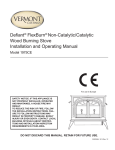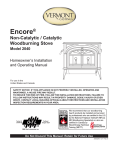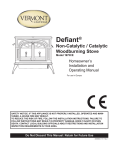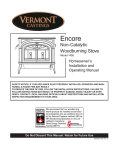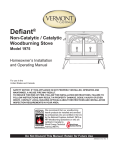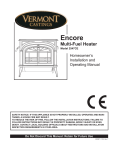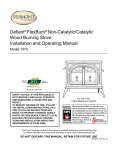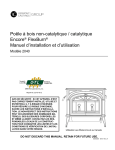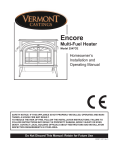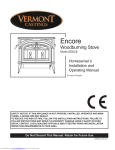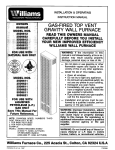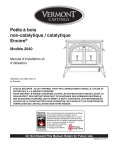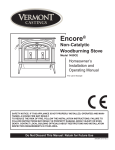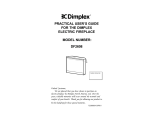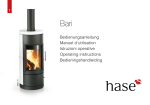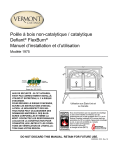Download Vermont Castings Encore Flexburn 2040 Specifications
Transcript
Encore® FlexBurn® Non-Catalytic/Catalytic Wood Burning Stove Installation and Operating Manual Model 2040CE For use in Europe SAFETY NOTICE: IF THIS APPLIANCE IS NOT PROPERLY INSTALLED, OPERATED AND MAINTAINED, A HOUSE FIRE MAY RESULT. TO REDUCE THE RISK OF FIRE, FOLLOW THE INSTALLATION INSTRUCTIONS. FAILURE TO FOLLOW INSTRUCTIONS MAY RESULT IN PROPERTY DAMAGE, BODILY INJURY OR EVEN DEATH. CONTACT LOCAL BUILDING OFFICIALS ABOUT RESTRICTIONS AND INSTALLATION INSPECTION REQUIREMENTS IN YOUR AREA. DO NOT DISCARD THIS MANUAL. RETAIN FOR FUTURE USE. 30005552 9/14 Rev. 10 Encore® 2040CE Non-Catalytic / Catalytic Wood Burning Stove Welcome Congratulations on your choice of a Vermont Castings Encore stove. With this purchase you have made a commitment to make the hearth a place of warmth, beauty and comfort in your home. At Vermont Castings Group, we share that joy and appreciation for the hearth. We assure you that your cast-iron Vermont Castings stove has been made with the utmost care and will provide you with many years of service. As you become acquainted with your new stove, you will find that its appearance is matched by its functionality, due to cast iron’s unique ability to absorb and radiate heat. Also, Vermont Castings Group products are among the cleanest-burning wood stoves and fireplaces available today. As an owner of a Vermont Castings stove, you make a strong statement for pollution-free energy. However, clean burning depends on both the manufacturer and the operator. Please read this manual carefully to understand how to properly operate and maintain your stove. At Vermont Castings Group, we are equally committed to your satisfaction as a customer. That is why we maintain an exclusive network of the finest dealers in the industry. Our dealers are chosen for their expertise and dedication to customer service. They are factory-trained and knowledgeable about every Vermont Castings Group product. Feel free to contact your Authorized Vermont Castings Dealer anytime you have a particular question about your stove or its performance. This manual contains valuable instructions on the installation and operation of your Vermont Castings Encore. It also contains useful information on maintenance. Please read the manual thoroughly and keep it as a reference. Sincerely, Vermont Castings Group Table of Contents This manual describes the installation, operation, and maintenance of the Vermont Castings Encore Model 2040CE Non-Catalytic / Catalytic wood burning heater. This heater meets the U.S. Environmental Protection Agency’s emission limits for wood heaters sold on or after July 1, 1990. Under specific test conditions this heater has been shown to heat 9.6kW (34,000 Btu/hr). The Encore Model #2040CE has been tested to current standards. The test standards are ANSI/UL-1482-2011 and ANSI/UL-737 for the United States, and EN13240:2001 + A2:2004 for Europe. The Encore is listed for burning wood only. Do not burn other fuels. We recommend that you hire a professional installer to install your stove, or to advise you on the installation should you attempt to install it yourself. Please read this entire manual before you install and use your new stove. Failure to follow instructions may result in property damage, bodily injury, or even death. Specifications ........................................................3 Installation .............................................................4 Assembly .............................................................12 Operation .............................................................15 Maintenance ........................................................18 The Chimney System ..........................................20 The Catalytic Element .........................................22 Replacement Parts ..............................................24 Warranty ..............................................................27 Installation Accessories Warming Shelf #0200 Classic Black #0205 Biscuit #0207 Ebony #0199 Bordeaux #0208 Brown Majolica #0198 Twilight #3265* #3185 #0336* #0127 FK26 #3190 8” Flue Collars #0555 Classic Black #0556 Biscuit #0557 Brown Majolica #0560 Bordeaux #0561 Twilight Outside Air Kit Outside Air Adapter Mobile Home Kit Firescreen Fan Kit Connector Pipe Heat Shield A line of porcelain enamel stove pipe is available in Biscuit, Bordeaux, Ebony, Brown Majolica colors. *If you order #3265 or #0336, you must also need #3185. Save These Instructions for Future Reference 2 30005552 Encore® 2040CE Non-Catalytic / Catalytic Wood Burning Stove Specifications Encore Model 2040CE Nominal heat out put ........7.8 - 8.0 kW (34,000 BTU/hr)1 Minimum flue draught ........................ 12 Pa (0.048” WG) Mean flue gas temp ................................ 339° C (642° F) Efficiency (Space heating) with Catalyst ............... 75.9% Efficiency (Space heating) w/o Catalyst ................ 72.9% Area heated ..................... Up to 167 sq. m (1800 sq. ft.)1 Fuel size/type .......................457-559 mm (18-22”) wood Fuel capacity ............................................. 22 kg (50 lbs) Flue mass gas flow ............................................... 6.6 g/s CO Emissions (@ 13% O2) ..w/Cat. 0.09% w/o Cat. 0.42 Loading .......................................................Front and top Chimney connector: for 8” flue collar ..........................203 mm (8”) diameter for 6” flue collar ..........................152 mm (6”) diameter Chimney flue size: for 8” flue collar ......................... 203 mm (8”) minimum for 6” flue collar ......................... 152 mm (6”) minimum Flue exit position...........................Reversible, top or rear Primary air ..... Manually set, thermostatically maintained Secondary air .................................Fixed, self-regulating Ash handling system ....................... Removable ash pan Glass panel.............................High-temperature ceramic Weight .................................................. 215 kg (475 lbs.) Width (leg-to-leg) ........................................685 mm (27”) Depth (leg-to-leg)........................................380 mm (15”) Height to top of flue collar ...........................635 mm (25”) 1. This value can vary depending on how the stove is operated, the type and moisture content of the fuel used, as well as the design, construction and climatic location of your home. Figures shown are based on nominal fuel consumption obtained under laboratory conditions and on average efficiencies. Drawings Not to Scale 578 mm (226M”) 95 mm (36M”) 44 mm (16M”) 686 mm (27”) 565 mm (2256M”) 394 mm (1556O”) 127 mm (5”) 73 mm (2(6”) 470 mm (1856O”) 635 mm (25”) Top exit flue collar height 654 mm (256M”) 603 mm (236M") 184 mm (756M”) 686 mm (27”) 381 mm (15”) Fig. 1 Encore 2040CE dimensions. 30005552 3 Encore® 2040CE Non-Catalytic / Catalytic Wood Burning Stove Installation SAFETY NOTICE: IF YOUR ENCORE IS NOT PROPERLY INSTALLED, A HOUSE FIRE MAY RESULT. TO REDUCE THE RISK OF FIRE, FOLLOW THE INSTALLATION INSTRUCTIONS. CONTACT LOCAL BUILDING OR FIRE OFFICIALS ABOUT RESTRICTIONS AND INSTALLATION INSPECTION REQUIREMENTS IN YOUR AREA. Before you begin an installation, be sure that: • Your stove and chimney connector will be far enough from combustible materials to meet all clearance requirements. • The floor protector is large enough and is constructed properly to meet all requirements. • You have all necessary permits from local authorities. Your local building official is the final authority for approving your installation as safe and determining that it meets local and state codes. The metal label permanently attached to the back of every Vermont Castings’ stove indicates the stove has been tested to current standards. The test standard is EN13240:2001 + A2:2004 for Europe. Clearance and installation information also is printed on the label. When the stove is installed according to the information both on the label and in this manual, local authorities in most cases will accept the label as evidence that the installation meets codes and can be approved. However, codes vary in different countries. Before starting the installation, review your plans with the local building authority. Your local dealer can provide any additional information needed. Outside Air In some modern, super-insulated homes, there is inadequate air for combustion because of insufficient air infiltration into the building. Such air enters a home through unsealed cracks and openings. Exhaust fans for kitchen or bath can compete with the stove for available air and compound the problem. When poor draft is caused by a low infiltration rate, opening a ground floor window on the windward side of the house and in the vicinity of the stove will usually alleviate the problem. For appliances with power outputs above 5 kW, a permanently open air vent is required by Section 2 of Document J. Air inlet grilles should be positioned so that they will not be blocked. Refer to local and national codes for recommended configurations. Pressure variations within the house do not affect a stove equipped with an outside air supply, and improved stove performance often results. An Outside Air Adapter Kit for the Encore is available from your local Vermont Castings dealer. Chimney Height Altitude affects chimney performance. When using a 6” flue collar on the Encore, refer to Figure 2 for suggested chimney heights at various altitudes. Chimney height should be measured from the flue collar to the top of the chimney. The recommended minimum chimney height is 4.9 m (16’). IMPORTANT: FAILURE TO FOLLOW THESE INSTALLATION INSTRUCTIONS MAY RESULT IN A DANGEROUS SITUATION, INCLUDING A CHIMNEY OR HOUSE FIRE. FOLLOW ALL INSTRUCTIONS EXACTLY, AND DO NOT ALLOW MAKESHIFT COMPROMISES TO ENDANGER PROPERTY AND PERSONAL SAFETY. Height (ft.) All local regulations, including those referring to national and European standards, need to be complied with when installing this stove. 30 25 6“ 20 15 0 2000 4000 6000 8000 10000 12000 ST491 Altitude (ft.) Fig. 2 Chimney height requirements for Encore when equipped with a 152 mm (6”) chimney. 4 30005552 Encore® 2040CE Non-Catalytic / Catalytic Wood Burning Stove What Kind of Chimney to Use Prefabricated Chimneys You must connect the Encore to a code-approved masonry chimney with a flue liner, to a relined masonry chimney that meets local codes, or to a prefabricated metal chimney. (Fig. 3) The chimney and chimney connector must be in good condition and kept clean. If you use an existing masonry chimney, it must be inspected to ensure it is in a safe condition before the stove is installed. Your local professional chimney sweep, building inspector, or fire department official will be able to inspect the chimney or provide a referral to someone who can. These should be an internal diameter of 150 mm (6”) and be of the twin wall insulated construction that has been approved for solid fuel use (e.g. Rite Vent ICS of ICID Lite Chimney Systems). Diameters over 200 mm (8”) are not recommended due to the large cross-section causing excessive cooling of the flue gases. The flue and chimney design must meet requirement J2, Part J of the building regulations 2000 (Combustion Appliances and Fuel Storage Systems). An Encore with an 203 mm (8”) flue collar is approved for venting into a masonry chimney with a nominal flue size of 203 x 203 mm (8” x 8”) or 203 x 305 mm ( 8” x 12”), and into a round flue with nominal flue size of 203 mm (8”). An Encore with a 152 mm (6”) flue collar is approved for venting into a masonry chimney with a nominal flue size of 203 x 203 mm (8” x 8”), and into a round flue with nominal flue of 152 mm (6”). A prefabricated doublewall insulated chimney DO NOT CONNECT THIS UNIT TO A CHIMNEY FLUE SERVING ANOTHER APPLIANCE. Chimney Size NOTE: When installed with a 6” flue collar, the Encore may not be operated with the front doors open. Whatever the flue collar size, an Encore may be vented into larger chimneys as well. However, chimneys with liners larger than 203 x 305 mm (8” x 12”) may experience rapid cooling of smoke and reduction in draft, especially if the chimneys are located outside the home. These large chimneys may need to be insulated or have their flues relined for proper stove performance. A tile-lined masonry chimney ST241 Fig. 3 Approved chimney types. Masonry Chimneys An inspection of the chimney must confirm that it has a lining. Do not use an unlined chimney. The chimney should have no cracks, loose mortar, other signs of deterioration, and blockage. Repair any defects before the chimney is used with your stove. Unused openings in an existing masonry chimney must be sealed with masonry to the thickness of the chimney wall, and the chimney liner should be repaired. Openings sealed with pie plates or wallpaper are a hazard and should be sealed with mortar or refractory cement. In the event of a chimney fire, flames and smoke may be forced out of these unused thimbles. The chimney should be thoroughly cleaned before use. A newly-built masonry chimney must conform to the standards of your local building code or, in the absence of a local code, to a recognized national code. Masonry chimneys must be lined, either with code-approved masonry or pre-cast refractory tiles, stainless steel pipe, or a code-approved, “poured-in-place” liner. The chimney’s clean-out door must seal tightly. 30005552 Accessories to help make the connection between stainless steel chimney liners and your Encore are available through your local dealer. Chimney Connector Guidelines A chimney connector is the double-wall or single-wall pipe that connects the stove to the chimney. The chimney itself is the masonry or prefabricated structure that encloses the flue. Chimney connectors are used only to connect the stove to the chimney, as in Figure 5. Connecting Flue Pipes Connector pipes should meet the requirements of the building regulations. This can be achieved by the use connecting fluepipes included in the following categories: a) Vitreous enamelled steel pipe complying with BS 6999: 1989 (1996); b) Pipes made from stainless steel as descirbed in BS EN 1008-1:1995 grades 1.4401, 1.4404, 1.4432 or 1.4436 with flue wall thickness of at least 1 mm; c) Mild steel fluepipes complying with BS 1449: Part 1: 1991, with a flue wall thickness of at least 3 mm; d) Cast iron fluepipes complying with BS 41: 1973 (1998). 5 Encore® 2040CE Non-Catalytic / Catalytic Wood Burning Stove Flue Pipes with a spigot and socket joint should be fitted with the socket facing upwards, to contain condensates and moisture within the flue. Joints should be made gas tight using proprietary jointing accessories, or, where appropriate, by packing joint with noncombustible rope and fire cement. Double-wall connectors must be tested and listed for use with solid-fuel burning appliances. Single-wall connectors should be made of 24 gauge or heavier steel. Do not use galvanized connector; it cannot withstand the high temperatures that can be reached by smoke and exhaust gases, and may release toxic fumes under high heat. The connector may be 152 mm (6”) or 203 mm (8”) in diameter. If possible, do not pass the chimney connector through a combustible wall or ceiling. If passage through a combustible wall is unavoidable, refer to the section on Wall Pass-Throughs. Do not pass the connector through an attic, a closet or similar concealed space. The whole connector should be exposed and accessible for inspection and cleaning. In horizontal runs of chimney connector, maintain a distance of 610 mm (24”) from the ceiling. Keep it as short and direct as possible, with no more than two 90° turns. Slope horizontal runs of connector upward 6 mm per metere (1/4” per foot) going from the stove toward the chimney. The recommended maximum length of a horizontal run is 914 mm (36”), and the total length should be no longer than 2.4 m (8’). In cathedral ceiling installations, extend the prefabricated chimney downward to within 2.4 m (8’) of the stove. Wear gloves and protective eyewear when drilling, cutting or joining sections of chimney connector. Double-wall Chimney Connectors Information on assembling and installing double-wall connectors is provided by the manufacturer of the double-wall pipe. Follow the manufacturer’s instructions exactly as you assemble the connector and attach it to the stove and chimney. Using chimneys and connectors from the same manufacturer makes the assembly and installation straightforward. NOTE: For installations using double-wall connectors, minimum clearances must conform to the listed clearances in the clearance chart on Page 14. If the Encore is equipped with the 203 mm (8”) flue collar, an oval-to-round adapter will be needed. Double-wall ovalto-round adapters are available from some manufacturers. Your local dealer can help you select the right connector. 6 Single-wall Chimney Connectors • Begin assembly at the flue collar of the stove. Insert the • • • first crimped end into the stove’s flue collar, and keep each crimped end pointing toward the stove. (Fig. 4) Using the holes in the flue collar as guides, drill 3 mm (1/8”) holes in the bottom of the first section of chimney connector and secure it to the flue collar with three #10 x 1/2” sheet metal screws. Secure each joint between sections of chimney connector, including telescoping joints, with at least three (3) sheet metal screws. The pre-drilled holes in the top of each section of chimney connector serve as guides when you drill 3 mm (1/8) holes in the bottom of the next section. Secure the chimney connector to the chimney. Instructions for various installations Fig. 4 the crimped end of the connector points follow. toward stove. Be sure the installed stove and chimney connector are correct distances from nearby combustible materials. NOTE: Special slip pipes and thimble sleeves that form telescoping joints between sections of chimney connector are available to simplify installations. They often eliminate the need to cut individual connector sections. Consult your local dealer about these special pieces. Securing the Single-wall Connector to a Prefabricated Chimney Follow the installation instructions of the chimney manufacturer exactly as you install the chimney. The manufacturer of the chimney will supply the accessories to support the chimney, either from the roof of the house, at the ceiling of the room where the stove is installed, or from an exterior wall. Special adapters are available from your local dealer to make the connection between the prefabricated chimney and the chimney connector. The top of such adapters attaches directly to the chimney or to the chimney’s ceiling support package, while the bottom of the adapter is screwed to the chimney connector. These adapters are designed so the top end will fit outside the inner wall of the chimney, and the bottom end will fit inside the first section of chimney connector. When assembled in this way, any soot or creosote falling from the inner walls of the chimney will stay inside the chimney connector. 30005552 Encore® 2040CE Non-Catalytic / Catalytic Wood Burning Stove Chimney Flue Elbow Thimble Sleeve Flue Liner Chimney Connector Keep sleeve end flush with flue tile Slip Pipe Standard Connector Oval to Round Adapter Flue Thimble ST243 Flue Collar Fig. 6 The thimble, made of either ceramic or metal, must be cemented securely in place. ST492 Without a thimble, a suitable length of chimney connector can be extended through the breech to the inner face of the flue liner, and cemented securely in place. Additional pieces of connector are then attached with sheet metal screws. Fireplace Installations Fig. 5 Chimney connection in a freestanding masonry installation. Securing the Single-wall Connector to a Masonry Chimney Both freestanding masonry chimneys and fireplace masonry chimneys may be used for your installation. Freestanding Installations If the chimney connector must pass through a combustible wall to reach the chimney, follow the recommendations in the Wall Pass-Through section that follows. The opening through the chimney wall to the flue (the “breech”) must be lined with either a ceramic or metal cylinder, called the “thimble”, which is cemented securely in place. Most chimney breeches incorporate thimbles, but the fit must be snug and the joint between the thimble and the chimney wall must be cemented firmly. A special piece called the “thimble sleeve,” slightly smaller in diameter than standard connectors and most thimbles, will facilitate the removal of the chimney connector system for inspection and cleaning. Thimble sleeves should be available from your local dealer. To install a thimble sleeve, slide it into the breech until it is flush with the inner flue wall. Do not extend it into the actual flue passage, as this could interfere with the draft. The thimble sleeve should protrude 1-2” (25-50mm) into the room. (Fig. 6) Use furnace cement and thin gasketing to seal the sleeve in place in the thimble. Secure the chimney connector to the outer end of the sleeve with sheet metal screws. 30005552 The chimney connector may be connected to the chimney above the fireplace opening or through the fireplace. Above the Fireplace The Encore may be connected to a chimney above a fireplace opening. (Fig. 7) In such installations, the stove is positioned on the hearth in front of the fireplace and the chimney connector rises from the stove top and then angles ninety degrees back into the chimney. The chimney liner should extend to the point at which the chimney connector enters the chimney. If the chimney connector from your installation enters the chimney above a fireplace, follow all the guidelines mentioned above for freestanding installations. In addition, give special consideration to the following points: • Check the clearance between the stove and the chimney • • connector, and any combustible trim or the mantel. Use the necessary combination of mantel, trim, and connector heat shields to achieve the required clearances. Check the clearance between the chimney connector and the ceiling. If no heat shields are used, the clearance should be at least 610 mm (24”). The fireplace damper must be sealed to prevent room air from escaping up the flue. However, it must be possible to re-open the damper to inspect or clean the chimney. 7 Encore® 2040CE Non-Catalytic / Catalytic Wood Burning Stove Check These Clearances * Flexible Connector * * Check These Clearances Mantel Shield Fireplace Adapter Kit “Positive Connection” Mantel DEFIANT Seal This Off ST244a ST245 Fig. 7 In this installation, the chimney connector attaches to the chimney above the fireplace opening. Through the Fireplace If your fireplace opening height is at least 737 mm (29"), you may install an Encore through the opening using a “positive connection” kit, available from your local dealer. These positive connection kits ensure a tight fit between the stove flue collar and the chimney flue. (Fig. 8) Fireplace installations, whether connected to the flue above or through the fireplace opening, have special clearance requirements to adjacent trim and the mantel. You’ll find the required safe clearances for Encore fireplace installations on Page 11. Floor protection requirements also apply to fireplace installations. This information is on Page 9. Wall Pass-Throughs Whenever possible, design your installation so the connector does not pass through a combustible wall. If you are considering a wall pass-through in your installation, check with your building inspector before you begin. Also, check with the chimney connector manufacturer for any specific requirements. Accessories are available for use as wall pass-throughs. If using one of these, make sure it has been tested and listed for use as a wall pass-through. Fig. 8 In this installation, the chimney connector enters the firepalce opening and then connects to the chimney. Figure 9 shows one method of passing a connector through a wall. All combustible material in the wall is cut away to provide the required 457 mm (18”) clearance for the connector. The resulting space must remain empty. A flushmounted sheet metal cover may be used on one side only. If covers must be used on both sides, each cover must be mounted on noncombustible spacers at least 25 mm (1”) clear of the wall. Your local dealer or your local building inspector can provide details for other approved methods of passing a chimney connector through a combustible wall in your area. DO NOT CONNECT AN ENCORE TO ANY AIR DISTRIBUTION DUCT OR SYSTEM. 457 mm (18”) clear space all around the pipe T ST494 Fig. 9 An approved wall pass-through. 8 30005552 Encore® 2040CE Non-Catalytic / Catalytic Wood Burning Stove Hearths This appliance must be installed on to hearth that meets the requirements of Part J of the Building Regulations 2000 (Combustion Appliances and Fuel Storage Systems). This can be achieved by ensuring that the hearth is constructed and sized in accordance with the guidelines included in section 2 of approved document ‘J’. The size and clearances of the hearth are as follows: The constructed hearth should be constructed in accordance with the recommendations in document J, and should be of minimum width 840 mm and minimum depth 840 mm (if a free standing hearth b) above) or a minimum projection of 150 mm from the jamb (if a recessed hearth a) above). Wood framing requires protection from radiant heat ST247e Fig. 11 Combustible supporting timbers may lie beneath fireplace hearths, requiring additional floor protection. Unless the stove hearth is completely noncombustible, the bottom heat shield should be installed to Costructional Hearth Dimensions as below provide radiant protection for framing which may be below the hearth. (Fig. 11) At least 150 mm or to a suitable heat resistant wall Appliance Appliance Doors Doors Hearth Surface Free of Combustible Material At least 150 mm Perimeter should be clearly marked e.g. edge of superimposed hearth At least 300 mm a) Fireplace recess Perimeter should be clearly marked e.g. edge of superimposed hearth b) Free standing ST912 Fig. 10 Noncombustible hearth surface dimensions. Floor Protection for Fireplace Installations Do not assume that your fireplace hearth is completely noncombustible. Many fireplace hearths do not meet the “completely noncombustible” requirement because the brick or concrete in front of the fireplace opening is supported by heavy wood framing. (Fig. 11) Because heat passes through brick or concrete readily, it can easily pass through to the wood. As a result, such fireplace hearths can be a fire hazard and are considered a combustible floor. Keep in mind, also, that many raised hearths will extend less than the required clearance from the front of the heater when it is installed. In such cases, sufficient floor protection as described above must be added in front of the hearth to satisfy the minimum floor protector requirement from the front of the stove: 406 mm (16”) from the front. 30005552 Hearth rugs do not satisfy the requirements for floor protection. Keep the Stove a Safe Distance from Surrounding Materials Both a stove and its chimney connector radiate heat in all directions when operating, and dangerous overheating of nearby combustible materials can occur if they are too close to the heat. A safe installation requires that adequate clearance be maintained between the hot stove and its connector and nearby combustibles. Clearance is the distance between either your stove (measured from the bottom edge of the stove’s top plate) or chimney connector, and nearby walls, floors, the ceiling, and any other fixed combustible surface. Your stove has special clearance requirements that have been established after careful research and testing to both US and European standards. These clearance requirements must be strictly observed. 9 Encore® 2040CE Non-Catalytic / Catalytic Wood Burning Stove In addition, furnishings and other combustible materials must be kept away from the stove as well. In general, a distance of 1219 mm (48”) must be maintained between the stove and moveable combustible items such as drying clothes, furniture, newspapers, firewood, etc. Keeping those clearance areas empty assures that nearby surfaces and objects will not overheat. Safe Ways to Reduce Clearances Clearances As with any solid fuel heating stove, extremely high surface temperatures can occur, particularly in the event of uncontrolled operation, e.g. if the doors are inadvertently left open. It is crucial that sufficient clearances are allowed to any combustible surfaces, e.g. wooden mantels or lintels, and to timber framed (studded) walls even if they are faced with noncombustible board. Detailed information on fireplace and hearth construction is provided in section 2 of Document J, all installations must comply with these requirements or with the relevant National or local building standards. Clearances to timber framed (studded) walls are included below. There are no specific minimum clearances to solid noncombustible surfaces (e.g. the sides and rear of Inglenook fire openings constructed from solid masonry) other than to allow safe access to the controls of the stove. For this reason minimum side clearances of 125 mm, and a minimum rear clearance of 50 mm are recommended. Summary of Clearances Minimum rear clearance from combustible walls (e.g. timber framed or studded walls) 254 mm (10”) measured from the rear edge of the stove top. (Fig. 12, B) Minimum side clearance from combustible walls 483 mm (19”) measured from the side edge of the stove top. (Fig. 12, A) Minimum distance from stove to movable combustible materials (e.g. furniture, drying clothes, etc.) 1220 mm (48”). B A ST486a Fig. 12 Minimum clearances. Connecting Flue Pipe - Clearances Single wall connecting fluepipes can reach extremely high temperatures; therefore, clearances from the connecting fluepipe (chimney connector) must comply with the requirements of Part J of Building Regulations 2000 (Combustion Appliances and Fuel Storage Systems). This can be achieved by following the recommendations of Approved Document ‘J’. These are as shown in Figure 13. Minimum recommended side clearances to noncombustible surfaces 125 mm (5”). Minimum recommended rear clearance to noncombustible surfaces 50 mm (2”). NOTE: The minimum thickness of solid noncombustible materials is specified in section 2 of Document ‘J’, in relation to the clearance of the appliance from the surface. As a general rule, the thickness of solid noncombustible material forming the recess of a fireplace is a minimum of 200 mm. 10 30005552 Encore® 2040CE Non-Catalytic / Catalytic Wood Burning Stove at least 3xD at least 3 x D D at least 1.5 x D D at 3 lea x st D at least 1.5 x D Fluepipe at least 1.5 x D at least 1.5 x D at least 1.5 xD Elevation Without Shield Plan Without Shield Elevation With Shield Air space of at least 12 mm between noncombustible shield and combustible material Plan With Shield ST911 Fig. 13 Connecting fluepipe clearances. 30005552 11 Encore® 2040CE Non-Catalytic / Catalytic Wood Burning Stove Assembly Set Up Your Stove Cast iron stoves are heavy, and it will take two to four people to move your Encore into position. Wipe the protective coating of oil from the griddle with a clean dry rag or a paper towel. Install the handle on the griddle. First, place the griddle upST516 side down at the edge of a flat surface and Fig. 14 Attach the griddle handle. assemble the handle as shown. With the handle pointing 45° from its final position, tighten the nut as far as possible with the pliers. Move the handle to its final position while still holding the nut with the pliers. Storing the Handle Use the removable handle to open or close the doors. After using it, remove the handle so it will not get hot. Store the handle in the handle holder installed behind the right front leg. (Fig. 15) Bottom Heat Shield ST857a Fig. 16 Attach the bottom heat shield. Adjust the Leg Levellers Lift the stove slightly so there is no weight on the leg while making the adjustment. Reverse the Flue Collar (If necessary) Reverse the flue collar by removing the two screws that attach it to the back of the stove. Be sure the gasket around the flue collar opening is in position when you screw the collar back onto the stove. Attach Flue Collar Heat Shield WARNING: The flue collar heat shield must be attached to the Encore stove. Use four #10 sheet metal screws supplied to secure the flue collar heat shield to the rear of the stove. (Fig. 17) Bottom Heat Shield Door Handle Holder Leg Bolt and Washer Attach the Damper Handle ST564 Fig. 15 Handle holder and heat shield positions. Use the 1/4” -20 x 3” screw to attach the damper handle to the damper stub on the left side. Install the Bottom Heat Shield Attach the Primary Air Thermostat Handle NOTE: The Bottom Heat Shield is required in most installations. Refer to Floor Protection, Page 9, for further details. 1. Loosen the four 1/4-20 hex head bolts from the corners of the ash drop on the stove bottom. 2. Align the bottom heat shield holes with the four bolts. The outside air cutout hole should be toward the rear of the stove. The unpainted side must face up towards the stove. 3. Pass all four bolts through the large end of the keyholes and then pulling the shield forward to engage the smaller ends of the keyhole slots. (Fig. 16) 4. Attach the heat shield sides by passing the slots over the bolt heads. Tighten the hex head bolts. The primary air thermostat handle is the smaller of the two black handles. Secure the handle to the stub on the right side of the stove with an 8-32 x 2” slot head machine screw. (Fig. 18) 12 30005552 Encore® 2040CE Non-Catalytic / Catalytic Wood Burning Stove Fan Kit Installation Sheet Metal Screws Flue Collar Heat Shield Sheet Metal Screws ST1180 Fig. 17 Install flue collar heat shield. WARNING: The flue collar heat shield must be installed in all vertical installations. The flue collar heat shield is not used when the flue collar is in the rear exit position. 1. Attach the fan assembly at the bottom edge of the inner back with two (2) 1/4-20 x 3/4” hex head screws. 2. Attach snapstat to the mounting holes on the underside of the bottom with two (2) 1/4-20 pan head screws. 3. Attach the rheostat holder (provided with the stove) under the right front wing of the bottom heat shield with two (2) #10 sheet metal screws. 4. Attach the rheostat to its holder by inserting the rheostat control shaft through the holder hole. Install the retaining ring and rheostat knob onto the shaft. 5. Secure the rheostat cable to the underside of the bottom heat shield using the wire tie provided and the hole at the right rear edge of the heat shield. 6. Fan will not operate until stove reaches approximately 43° C (109° F). 7. Plug blower cord into a grounded outlet. Do not remove ground prong from plug. Route power cord to avoid heat from the stove or other damage. Do not route cord under or in front of appliance. Hole for Wire Tie to Secure Cable ST635 Rheostat Knob Fig. 18 Attach the thermostat handle. Assemble the Removable Insert Handle The ceramic removable insert handle opens and closes the front doors. Remove after each use, and store it in the handle holder behind the right front leg. Assemble the handle by passing the 33⁄8" screw through the ceramic shaft and into the bright metal nub. (Fig. 19) Tighten carefully until snug. Rheostat Holder Rheostat Snapstat Screws ST848 Fig. 20 Fan installation (Kit # 2767). ST540 Fig. 19 Assemble the front door handle. 30005552 13 Encore® 2040CE Non-Catalytic / Catalytic Wood Burning Stove Installing or Removing Catalyst 1. Remove the access cover by gently lifting up and pulling out from the bottom edge. (Fig. 21) 2. Remove the inner cover by pulling it straight out. (Fig. 22) 3. Remove the catalyst by gently pulling it straight out. (Fig. 23) Place the catalyst where the catalyst’s ceramic components will not be damaged. Access Cover Remove Catalyst ST1189 Fig. 23 Remove catalyst. ST1187 Fig. 21 Remove access cover. Inner Cover ST1188 Fig. 22 Remove inner cover. 14 30005552 Encore® 2040CE Non-Catalytic / Catalytic Wood Burning Stove Operation The Encore Controls Two controls regulate the performance of the Encore: a primary air control supplies oxygen for the fire, and a damper directs air flow within the stove to activate and deactivate the catalytic combustor. Low Heat Symbols cast into the stove are reminders of the correct directions for opening and closing the controls. The symbols assume that you are facing the front of the stove. Damper Handle Griddle Handle Door Handle High Heat Air Control Lever ST637 Fig. 25 The handle may be positioned anywhere between the two extremes for different heat levels. Door Handle Holder (Behind leg) Ashdoor Handle Andirons ST636 Fig. 24 The Encore controls are conveniently located and easy to operate. A Single Air Control Regulates Heat Output and Burn Time The primary air control lever, located on the right side of the stove, controls the amount of incoming air for starting, maintaining, and reviving a fire. damper must be open when starting or reviving a fire, and whenever the griddle or doors are opened. The damper is closed when the handle points forward. Smoke travels through the non-catalytic combustion system where it can be further burned, before passing up the chimney. (Fig. 26) The damper should always be either fully open or fully closed. There are no intermediate positions. When closing the damper, be sure to pull firmly enough to snap the handle into the locked position. Damper Positions Open (Updraft Mode) More air entering the stove makes the fire burn hotter and faster, while less air prolongs the burn at a lower heat level. High and low settings appear in Figure 25. For the greatest air supply and maximum heat output (but the shortest burn time), move the lever toward the front of the stove. For a fire that will last longer with less heat, move the lever toward the rear of the stove. The Encore’s air control system also features an automatic thermostat to ensure an even heat output at whatever manual setting you select. The thermostat senses the heating and cooling of the stove surface and adjusts the air shutter accordingly. A Damper Directs Air Flow Within the Stove The damper handle on the left side of the stove operates the damper to direct air flow within the stove. The damper is open when the handle points to the rear, enabling smoke to pass directly into the chimney. The 30005552 Closed (High Efficiency Mode) ST638 Fig. 26 The damper is either open or closed. There are no intermediate positions. High-Efficiency Wood Burning with Catalytic Combustion An Encore leaves the factory with the combustor packaged separately. In the United States, it is against the law to operate this wood heater in a manner inconsistent with operating instructions in this manual. The components of the catalytic 15 Encore® 2040CE Non-Catalytic / Catalytic Wood Burning Stove combustion system in your Encore work together to produce optimum conditions for secondary combustion. When the damper is closed, smoke travels through the catalytic element, which causes ignition of smoke at temperatures of 260°-315°C (500°-600° F), half the temperature normally required for unaided secondary combustion. The catalytic element is a ceramic “honeycomb” coated with the catalytic material. The element is located in the secondary combustion chamber, molded from a special high-temperature insulating refractory material. The chamber provides the correct environment necessary for secondary combustion of the fuel (smoke). Closing the damper exposes the smoke to the combustor. If the combustor is at least 315°C (600°F), it will begin to burn the smoke. Closing the stove damper may also reduce the draft, so to avoid putting out the fire or deactivating the combustor, close the damper only when a fire is well-established and the chimney is thoroughly warmed. When starting a fire, wait until the fire is well established and there is an ember bed of at least 75 - 100 mm (3-4 inches) before closing the damper. Never kindle a fire with colored paper or paper that has colored ink or a glossy surface, and never burn treated wood, garbage, solvents, or trash. All of these may poison the catalyst and prevent it from operating properly. Never burn cardboard or loose paper except for kindling purposes. Never burn coal; doing so can produce soot or large flakes of char or fly ash that can coat the combustor and cause smoke to spill into the room. Coal smoke also can poison the catalyst so that it won’t operate properly. IMPORTANT: Do not burn any type of artificial or synthetic materials such as fire starter logs (containing wax) in this appliance. Never burn liquid-based fuels such as kerosene, gasoline or alcohol. Burning any materials not allowed in these instructions, or over-firing the stove, may void the warranty. In general, the fire must be sufficiently well-established to ensure that catalytic activity is initiated. When first starting a fire, a medium- to high- firing rate must be maintained until the stove, catalyst, and fuel are all stabilized at the proper operating temperatures, and the chimney is warmed. Even though it is possible for the fire to get quite hot within a few minutes after a fire is started, the combustor may stop working or the fire may go out if the fire dies down immediately as a result of the damper being closed. Once the combustor starts working, heat generated by burning the smoke will keep it working. Avoid using a full load of very dry wood in the firebox. This may result in continuous very high temperatures in the secondary combustion area and damage the combustor. Wood which has been split, and stored under cover for more than 18 months may be considered very dry. If you must burn extra-dry wood, mix it with greener wood for a longer fire and less stress on the combustor. Also, do not use a full load of dry slab wood or scrap wood. For long burns, use a mix of dry and moderately dry wood. Two Ways to Add Fuel The Encore’s griddle lifts for convenient top-loading of logs, and is the easiest way to add fuel. (Fig. 27) However, the front doors open as well for adding an occasional log to a fire. If the stove is equipped with 8” (203 mm) stove pipe, the front doors may be opened (or even removed) and the optional Encore spark screen placed in the opening for open-fire viewing. The Encore is not approved for operation with the front doors open if equipped with a 152 mm (6”) chimney connector or chimney. Def iant ST521 Fig. 27 Top loading is the best way to add fuel during regular use. Front loading is useful for kindling a fire. To open the front doors, insert the handle into the door latch stub and turn it to the left and up. (Fig. 28) To close them, always close the left door first. Turn the handle in the right door to the left and up (to the open position) and close it. Finally, push on the door as you turn the handle to the right and down. The doors will draw in slightly, and the handle should offer some resistance as you turn it to the closed position. To reduce the risk of breaking the glass, avoid striking the glass or slamming the doors. When you are not using the door handle, store it in the holder behind the right front leg of the stove. Be careful to not drop the handle, since it is breakable. To determine whether the combustor is operating, observe the amount of smoke leaving the chimney when the damper is activated and when it is not. This procedure is described on Page 22. 16 30005552 Encore® 2040CE Non-Catalytic / Catalytic Wood Burning Stove Clockwise to Open Counterclockwise to Close ST544 Fig. 28 To open the front doors, turn the handle clockwise. CAUTION: The Encore will be hot while in operation. Keep children, clothing and furniture away. Contact may cause skin burns. DO NOT OVERFIRE THIS HEATER. Overfiring may cause a house fire, or can result in permanent damage to the stove and to the catalytic combustor. If any part of the Encore glows, you are overfiring. Ash Disposal You should remove ash before it reaches the top of the ash pan. Check the level at least once a day. Every few days, clear any ash from the outer edges of the firebox. Most of the ash will fall through the grate. Slice or stir the ash with a shovel or poker so that it falls through the grate slots. IMPORTANT: Check the level of ash in the ash pan before reloading the stove. If the ash level is close to the top edge of the pan, empty the pan according to this procedure: • Open the damper. • Open the griddle or front doors, and use a shovel or • • • • poker to stir excess ash through the ash slots in the grate down into the ash pan. Close the griddle or doors, and unlatch the ash door. It will pivot, swinging the ash pan out of the stove. Slide the cover onto the pan, making sure it is securely closed. (Fig. 29) Remove the ash pan, making sure to keep it level. To keep the cover from sliding off and to keep ash from falling on the floor, do not tilt the ash pan forward. If the stove is in operation, close the ash door while disposing of the ash. ST566 Fig. 29 Be sure the cover is securely attached before removing the ash pan. • Properly dispose of the ash in a metal container with a • • tight-fitting lid. Store the container outdoors away from all combustible material. Return the ash pan to its original position in the stove, and close and latch the ash door. Do not operate the stove with the ash door open. This will result in over-firing, and could cause damage to the stove, void the warranty, or even lead to a house fire. Empty the ash pan regularly, typically every one to three days. The frequency will vary depending on how you operate your Encore: ash will accumulate faster at higher heat outputs. Remove ash frequently and place it outdoors in a metal container with a tight-fitting lid. Place the closed container of ash on a noncombustible floor or on the ground, well away from all combustible materials, pending final disposal. If the ash is disposed of by burial in soil or otherwise locally dispersed, it should be kept in the closed container until all cinders have thoroughly cooled. You can use wood ash as a garden fertilizer. CAUTION: Never use your household or shop vacuum cleaner to remove ash from the stove; always remove and dispose of the ash properly. Open Close ST545 Fig. 30 Turn the handle to the ash pan compartment clockwise to open and counterclockwise to close. 30005552 17 Encore® 2040CE Non-Catalytic / Catalytic Wood Burning Stove Maintenance Keep Your Stove Looking New and Working Its Best Let the fire in the stove go out and allow the stove to cool completely before beginning any maintenance procedure. Care of the Cast Iron Surface An occasional dusting with a dry rag will keep the painted cast iron of your Encore looking new. The stove’s paint can be touched up as needed. First, mask the areas, such as enamelled parts, glass, or handles, around the spot to be painted. Clean the spot with a wire brush. Remove the griddle and set it aside. It is normal for the griddle to darken after use. You can clean it with a fine-bristle wire brush, or steel wool. Then, touch up the stove with Vermont Castings’ high temperature stove paint. Apply the paint sparingly; two light coats of paint are better than a single heavy one. Care of the Porcelain Enamel Surface Use a dry or slightly damp rag or soft brush to remove spills or stains. For difficult jobs that require a cleaning agent, use only a kitchen appliance cleaner or polish recommended for use on enamel surfaces. If porcelain enamel becomes chipped or scratched during use, apply “enamel epoxy” to the damaged area and allow to dry. Once the epoxy has dried, sand the area to blend with surrounding area and apply appropriate color touch-up paint. Allow to dry completely before operating stove. Cleaning the Glass Most of the carbon deposits on the glass will burn off during hot fires. However, the ash residue that accumulates on the glass surface should be removed regularly to prevent etching. To clean the glass, follow this procedure: • Be sure the glass is completely cool. • Clean the glass with water or a cleaner made especially • • for this purpose. Do not use abrasive cleaners. Use cleaning agents sparingly and be sure to keep them off the outer surfaces of the stove. Rinse the glass thoroughly. Dry the glass completely. Replace Broken Glass Immediately Do not operate your stove if the glass in the doors is damaged. If you need to replace the glass, use only the high temperature 5 mm ceramic glass supplied by Vermont Castings. Do not use substitutes. Removing the Glass 1. Remove the right and left door assemblies by raising the door until the lower hinge pin clears its hole; then, angle the door bottom slightly outward and pull down to release the upper hinge pin. Place the doors face down on a padded work surface. Be especially careful with enamelled doors. 2. Remove the screws that hold the glass retainer clips in place, and remove the clips. 3. Carefully lift the broken glass panel from the door. Installing the Glass Check the gasket around the window; it should be soft and resilient so that the glass will seal properly against the door. Replace the gasket if it has hardened or if it is compressed. 1. Center the glass on the gasket. 2. Secure the glass on both doors with the retainer clips. Tighten all screws. (Fig. 31) 3. Replace the doors on the stove. 4. Open and close the doors to check that they fit and work properly. Adjust as necessary. Right Door Gasket Glass Panel Retainer Clips (4) ST854 Fig. 31 Exploded view of the glass assembly for the right door. 18 30005552 Encore® 2040CE Non-Catalytic / Catalytic Wood Burning Stove Adjust the Damper as Needed Roller The tension on the Encore’s damper is adjustable to compensate for compression of the gasket that seals the damper to the upper fireback. To adjust the damper: 1. Remove the griddle. Loosen the lock nut at the center of the damper. (Fig. 32) 2. Turn the pressure screw approximately one half turn clockwise with an Allen wrench provided with your stove. 3. Tighten the lock nut. Prevent the pressure screw from turning as you tighten the nut. Re-test the damper. Shoulder Screw Lock Nut Set Screw Pressure Adjusting Screw Flat Washer Lock Nut Allen Wrench Damper ST1154 Fig. 33 Rotate pawl and/or remove flat washer to adjust latch. is raised and makes contact with the door frame. If this procedure doesn’t solve the problem, replace the gasket. Instructions for gasket replacement are given later in this section. ST554 Fig. 32 Adjust the damper with the Allen wrench. Tighten the Damper Handle as Needed A handle on the left side of the stove controls the damper. The handle attaches to the damper rod with a set screw. Periodically check the set screw and tighten as necessary. How to Adjust the Door Latches The front door of the stove should close securely to prevent accidental opening and should close tightly to prevent air from leaking into the fire chamber. The door handle will be positioned vertically when the door is closed. Over a period of time, the gasket around the door will compress and the latch may need adjustment. To adjust the handle, follow this procedure: 1. Remove and retain the lock nut with a 9/16” wrench. (Fig. 33) 2. Loosen the set screw with a 1/8” Allen wrench. 3. Rotate the pawl 180°. Replace the lock nut. Tighten the set screw. 4. Additional adjustment can be made by removing the flat washer. Or any combination of washer removal and/or pawl rotation. Test the door seal. Close the door on a dollar bill and attempt to pull it free. If the bill is freed with little resistance, the gasket isn’t snug enough at that spot. Continue to make small adjustments until the setting is right. If additional adjusting of the latch does not enable the door to seal sufficiently in one area, try “adjusting” the gasket in that area. Pack more cement or a smaller diameter gasket into the channel beneath the gasket so the main gasket 30005552 Handle Stub Replace the Stove Gaskets as Needed Your Encore uses fiberglass rope gaskets to make a tight seal between some parts. With use, particularly on moving parts, gaskets can become brittle and compressed and can begin to lose their effectiveness. These will need periodic replacement. The sizes of replaceable gasket are listed below, along with their applications. Gasket Diameter... ...And the Parts it Seals 5/16” The griddle to the stove top (wire reinforced gasket) 5/16” The damper to the upper fireback 3/8” the front doors to the stove front; and the doors to each other. 3/8” panel The ash door to the front of the bottom 3/16” The outer glass panes to the door If you need to change a gasket, first obtain an appropriate replacement from your Vermont Castings’ Authorized Dealer. Wait until the fire is out and the stove has cooled. Be sure to follow the standard safety procedure for working with dusty materials: wear safety goggles and a dust mask. The procedure for replacing gaskets is the same, regardless of the gasket location. Follow these steps: 1. Remove the existing gasket by grasping an end and pulling firmly. (Fig. 34) 2. Use a wire brush or the tip of a screwdriver to clean the channel of any remaining cement or bits of gasket. Remove stubborn deposits of cement with a cold chisel if necessary. (Fig. 34) 19 Encore® 2040CE Non-Catalytic / Catalytic Wood Burning Stove All Gasketed Construction Gaskets ST560 Fig. 34 Remove gasket then clean channel with wire brush. 3. Determine the correct length of the appropriate-sized gasket by laying it out in the channel. Allow an extra 1-2” (25-50 mm), and mark the spot to be cut. 4. Remove the gasket from the channel, place it on a wood cutting surface, and cut it at the marked spot with a utility knife. Twist the ends slightly to keep the gasket from unraveling. 5. Lay an unbroken 1/8” (3 mm) bead of silicone or cement in the newly-cleaned channel. (Fig. 35) sket e Ga nt Stov Ceme ST561 Fig. 35 Lay a bead of gasket silicone or cement then press gasket in place. 6. Starting at one end, press the gasket into the channel. (Fig. 35) Ensure a good joint where the gasket meets before trimming any excess. Do not overlap the gasket ends or leave ends with ragged edges. 7. Press the gasketed part firmly against its normal mating surface to seat the gasket evenly in its channel. Close and latch the door to do this, or tap other parts with the rubber mallet (or hammer/block of wood). 8. Clean any excess cement from around the channel, then let the cement that holds the new gasket dry thoroughly. 9. The stove’s doors may need adjustment after you have regasketed them. Initially, it may require loosening the latch to accommodate the new gasket; after a few weeks, it may need tightening to compensate for compression of the new gasket. The directions for adjusting the latches are on Page 19. 20 Other gaskets form seals between all other non-moving parts, but these are not subject to the same wear and deterioration as gaskets on moving parts. It is unlikely that you will ever need to replace these gaskets unless the involved parts are disassembled and then put back together. If this is the case, the job should be done only by a qualified service technician. 5/16” diameter gasket seals the following parts: • The lower fireback to the back panel • The left and right air plates (inner sides) • All connections between the stove plates. The Chimney System Creosote Your Encore is designed to reduce creosote build-up significantly. However, regular chimney inspection and maintenance must still be performed. For safety, good stove performance, and to protect your chimney and chimney connector, inspect your chimney and chimney connector on a regular schedule. Clean the system if necessary. Failure to keep the chimney and connector system clean can result in a serious chimney fire. When wood is burned slowly, it produces tar, organic vapors and moisture that combine to form creosote. The creosote vapors condense in the relatively cool chimney flue of a slow-burning fire. As a result, creosote residue accumulates on the flue lining. When ignited, this creosote makes an extremely hot fire within the flue system that can damage the chimney and overheat adjacent combustible material. If a significant layer of creosote has accumulated —1/8” (3 mm) or more — it should be removed to reduce the risk of a chimney fire. You can never be too safe. Contact your local fire authority for information on what to do in the event of a chimney fire, and have a clearly understood plan on how to handle one. If you do experience a chimney fire, act promptly to: • Close the damper and air control lever. • Get everyone out of the house. • Call the Fire Department. Inspect the system every two weeks during the heating season as part of a regular maintenance schedule. To inspect the chimney, let the stove cool completely. Then, using a mirror and a strong light, sight up through the flue collar into the chimney flue. If you cannot inspect the flue system in this fashion, the stove must be disconnected to provide better viewing access. 30005552 Encore® 2040CE Non-Catalytic / Catalytic Wood Burning Stove Clean the chimney using a brush the same size and shape as the flue liner. Flexible fiberglass rods are used to run the brush up and down the liner, causing any deposits to fall to the bottom of the chimney where they can be removed through the clean-out door. Clean the chimney connector by disconnecting the sections, taking them outside, and removing any deposits with a stiff wire brush. Reinstall the connector sections after cleaning, being sure to secure the joints between individual sections with sheet metal screws. If you cannot inspect or clean the chimney yourself, contact your local Vermont Castings dealer or a professional chimney sweep. The Chimney Connector TWO WEEKS: • Inspect the chimney connector and chimney. Clean if necessary. TWO MONTHS: • Inspect the chimney and chimney connector. Pay particular attention to the horizontal runs of chimney connector, and the elbows. Clean the system if necessary. ANNUAL SPRING CLEANING: • Disassemble the chimney connector and take it outdoors Maintenance Schedule The Stove • DAILY: • Clear any ash build-up from around the air holes and combustion flow path in the lower fireback. • Ashes should be removed before they reach the top of the ash pan. Check accumulation at least once a day. • Keep the area around the stove clear of any combustible materials such as wood, furniture or clothing. TWO MONTHS: • Check door handle to be sure it is working properly. Gasketing becomes compressed after a period of time. Adjust handle tightness if necessary. • Check leg bolts and heat shield screws; tighten if necessary. ANNUAL SPRING CLEANING: • Check gasketing for wear, and replace if necessary. • Remove ashes from the ash pan and replace with a moisture absorbing material (such as kitty litter) to keep the interior of the stove dry. • Clean the dust from the inner sides of bottom, rear or pipe heat shields if your stove is equipped with them. Clean surfaces are better heat reflectors than dirty surfaces. • Touch up the black paint. • Inspect for and remove ash build-up behind the combustion package. This should be done in conjunction with annual cleaning of the chimney connector. Inspect the passage behind the combustion package (a mirror will be helpful) and vacuum away ash using a flexible vacuum hose inserted in the passage. (Fig. 36) 30005552 • for inspection and cleaning. Replace weak sections of connector. Inspect the chimney for signs of deterioration. Repairs to a masonry chimney should be made by a professional mason. Replace damaged sections of prefabricated chimney. Your local Vermont Castings dealer or a chimney sweep can help determine when replacement is necessary. Thoroughly clean the chimney. Clean out any ash build up Remove these components ST1162 Fig. 36 Inspect and clean out ash accumulation behind the combustion system. 21 Encore® 2040CE Non-Catalytic / Catalytic Wood Burning Stove The Catalytic Element This wood heater contains a catalytic combustor, which needs periodic inspection and replacement for proper operation. In the United States it is against the law to operate this wood heater in a manner inconsistent with the operating instructions in this manual. Under normal operating conditions, the catalytic combustor should remain active for two to six years (depending on the amount of wood burned). However, it is important to monitor the combustor periodically to ensure that it is functioning properly, as well as to determine when it needs to be replaced. A non-functioning combustor will result in a loss of heating efficiency, and an increase in creosote and emissions. Once you have ruled out any other possible causes for a decline in performance, inspect and clean the combustor if necessary. Be sure to protect any surface you use for setting the stove parts aside. Inspecting the Combustor Remove access door and inner fireback. Remove the catalytic combustor by lifting and sliding it towards you. (Fig. 37) Catalyst Inspection and Cleaning Inspect the combustor for fly ash accumulation and physical damage three times per year. Clean the combustor as needed. The refractory package that houses the catalytic combustor should be inspected for a buildup of fly ash and cleaned if necessary. This may be done when you examine the combustor. When to Suspect a Combustor Problem The best way to evaluate the performance of your Encore’s combustor is to observe the amount of smoke leaving the chimney — both when the combustor has “lighted-off” and when it has not. Follow these steps: • With a fire going and the combustor properly activated, with the damper closed to route smoke through it as described in the Operation Section, go outside and observe the smoke leaving the chimney. • Then, open the stove damper and once again check the smoke leaving the chimney. You should see significantly more smoke when the stove damper is open and exhaust does not pass through the combustor. However, be careful not to confuse smoke with steam from wet wood. Steam dissipates in the air quickly; smoke does not. If this test indicates a problem, consider other possible factors as well, such as the weather or a change in the quality of your fuel. In warm weather, draft is weaker than it is in colder winter weather, and fires can burn sluggishly. Small, hot fires are a good solution under these conditions. Burning “green” (insufficiently seasoned) wood will result in poorer performance than burning properly seasoned fuel. You may have to run your stove hotter (more air) to achieve acceptable performance using green or wet wood. Also, consider any changes in your operating routine. 22 Inner Fireback Access Door ST1180 Fig. 37 Inspect the catalytic combustor. To assure a long life for the combustor, it is recommended to service the combustor on a regular basis based on the amount of use. This procedure takes about five (5) minutes and requires no tools except for a vacuum if cleaning is necessary. Cleaning the Combustor 1. Check the combustor’s honeycomb-like element for a buildup of fly ash. If any is evident, take the combustor outside and clean it by blowing air gently through it. Do not push anything through the honeycomb; do not use compressed air to clear the passages. Such abrasion can scrape the thin coating of platinum (the catalyst) off the ceramic base, shortening the catalyst’s life and reducing its effectiveness. 2. Inspect the element for damage or degradation. Although small hairline cracks will not affect performance, the element should be essentially intact. If the element is broken in pieces or has sections missing, it should be replaced. Call your local Vermont Castings Authorized Dealer for a replacement element. 30005552 Encore® 2040CE Non-Catalytic / Catalytic Wood Burning Stove 3. If the element is in good condition and clean, re-install it in the stove and replace the refractory inner fireback and access door. Operate the stove in your usual manner for two weeks, inspecting the chimney and the chimney connector frequently during this period. If creosote does not build up as fast, it is likely that the performance change was caused by fly ash deposits on the catalytic element. However, continue the inspections of the chimney system for a few weeks to ensure that proper performance continues. If you continue to find a significant creosote buildup or if you continue to see excessive smoke from the chimney, the catalytic element will need to be replaced. Contact your nearest Vermont Castings’ Authorized Dealer for information about a replacement element. NOTE: Use only the replacement catalyst supplied by a Vermont Castings dealer. 30005552 23 Encore® 2040CE Non-Catalytic / Catalytic Wood Burning Stove Encore Non-catalytic/Catalytic Wood Burning Stove Model 2040CE 14 17 9 12 20 11 2 21 22 56 63 88 19 33 80 3 57 1 10 78 16 58 18 32 60 41 23 35 8 13 23 25 44 84 46 15 42 6 43 38 4 86 31 36 24 85 76 71 7 65 87 27 26 39 72 77 45 68 40 82 89 74 29 26 28 73 72 49 30 67b 37 34 75 90 81 70 47 59 5 16 79 61a 27 67a 55 49 79 82 65 48 83a 61b 83 53 69 52 62 83b 50 51 54 Vermont Castings Group reserves the right to make changes in design, materials, specifications, prices and discontinue colors and products at any time, without notice. 24 30005552 Encore® 2040CE Non-Catalytic / Catalytic Wood Burning Stove Encore Non-catalytic/Catalytic Wood Burning Stove Model 2040CE (continued) Item Description 1. 2. 3. 4. 5. 6. 7. 8. 9. 10. 11. 12. 13. 14. 15. 16. 17. 18. 19. 20. 21. 22. 23. 24. 25. 26. 27. 28. 29. 30. 31. 32. 33. 34. 35. 36. 37. 38. 39. 40. 41. 42. 43. 44. 45. 46. 47. 48. Brick Support Bracket Griddle Gasket Back Refractory Rt End Refractory Lt End Refractory Support Gasket, Fiber, Refractory Support Back Insulation Board Outer Back Left Griddle Quadrant Right Griddle Quadrant Griddle HS Flue Collar Bracket Upper Side Catalyst, Ceramic Damper Ashdoor Gasket Damper Ramp Damper Housing Damper1 Damper Tab1 Damper Rod1 Griddle Handle Assy Gasket, Fiber Back Refractory Rheostat Bracket Refractory, Engine - E/D Damper Handle Screw Damper Handle Damper Handle w/Screw Assy Left Side Left Air Manifold Right Air Manifold Right Side Thermostat Handle Base Washer Damper Rod Fireback Plate, S/S Inner Bottom Ashdoor Hinge Upper Door Handle Bracket Bottom Outer Ashlip Gasket, Fireback Refractory, Fireback Retainer, Fireback Refractory Refractory, Inner Cover Andiron Refractory, Access Cover Leg Leveller Ashdoor Handle Shaft 30005552 Item Description Part Number 30005279 1203668 30005289 30005497 30005498 30005233 30005237 30005269 30005261 30002399 30002401 30002386 30005266 30005267 30005353 1203588 1301811 30005293 30006467 1601488 1600851 30002775 30005270 30002863 30005202 1201310 1600664 30002720 See Chart Pg. 26 30002408 30005290 See Chart Pg. 26 30002716 1202560 30005217 30005291 30002403 30002909 30005292 See Chart Pg. 26 30005209 30005302 30005248 30005205 30002397 30005303 1201745 1600622 49. 50. 51. 52. 53. 54. 55. 56. 57. 58. 59. 60. 61a. 61b. 62. 63. 65. 66. 67a. 67b. 68. 69. 70. 71. 72. 73. 74. 74a. 74b. 75. 75a. 76. 77. 78. 79. 80. 81. 82. 83. 83a. 83b. 84. 85. 86. 87. 88. 89. 90. Pawl Assy Ashdoor Ashdoor Handle (Wood) Ashdoor Hinge Rod Cotter Pin, Ashdoor Ashdoor Hinge Lower Ashpan Bracket Lower Side Bracket Thermostat Handle Front Manifold Front Flue Collar Gasket Left Door Left Door Door Hinge Strip Top Glass Clip Long Front Door Handle & Shaft Right Door Right Door Door Gasket Glass Gasket Left Door Glass Right Door Glass Door Hinge Pin Spacer (for Damper rod) Primary Air Valve Assy. Primary Air Frame Primary Air Rod Complete Handle Assy Handle Base Stub Thermostat Friction Spring Thermostat Cable Thermostat Handle Bolt Ash Pan Assy Flue Collar Leg Hex Head Jam Nut Bottom Heat Shield Bottom Heat Shield Rt Wing Bottom Heat Shield Lt Wing Grate Bottom Thermostat Assy. Washer Handle Base Stub Thermostat Handle Assy Primary Air Cover Primary Air Base Part Number 30005157 30002392 1600663 30002473 30001749 30002404 1601039 30005268 1600660 30002407 See Chart Pg. 26 30002422 See Chart Pg. 26 See Chart Pg. 26 1308634 See Chart Pg. 26 1601396 30002717 See Chart Pg. 26 See Chart Pg. 26 1203588 1203556 30005300 30005299 30002727 1201779 30005324 1307411 30005260 30004175 30002714 1201846 5005471 1201243 5005746 See Chart Pg. 26 See Chart Pg. 26 1203290 30002470 30005030 30005031 30005294 5005470 1202471 30002714 30007067 30007069 30007071 25 Encore® 2040CE Non-Catalytic / Catalytic Wood Burning Stove Encore Non-catalytic/Catalytic Wood Burning Stove Model 2040CE (continued) SHELL ENAMEL PARTS: ENCORE® MODEL 2040 Part Name Classic Black Biscuit Bordeaux Ebony Majolica Brown Twilight Top 30002387 30003055 30006682 30003075 30004879 30007030 Left Side 30002388 30003052 30006679 30003072 30004876 30007027 Right Side 30002405 30003053 30006680 30003073 30004877 30007028 Flue Collar 1305050 30003160 30006683 30003162 30004873 30007031 Front 30002393 30003054 30006681 30003074 30004878 30007029 Ashlip 30002402 30003051 30006678 30003071 30004875 30007026 Left Door Sub Assembly* 30003974 30003984 30006687 30003988 30004882 30007072 Left Door (61a) 30003938 30003958 30006685 30003962 30004884 30007033 Right Door Sub Assembly* 30003975 30003985 30006686 30003989 30004881 30007073 Right Door (67a) 30003939 30003959 30006684 30003963 30004883 30007032 Single Leg 30002396 30003050 30006677 30003070 30004874 30007025 TRANSITION DOOR ENAMEL PARTS: ENCORE® MODEL 2040 Part Name Left Door Assembly Classic Black Biscuit Bordeaux Majolica Brown Twilight 30007165 30007167 30007169 30007171 30007173 Left Door (61b) 30007081 30007083 30007087 30007085 30007107 Right Door Assembly 30007166 30007168 30007170 30007172 30007174 Right Door (67b) 30007080 30007082 30007086 30007084 30007106 *Does not contain glass or glass gasket. NOTES: In the diagram and throughout this manual, ‘left’ and ‘right’ mean as you face the front of the stove. When ordering parts, be sure to mention the stove’s model number. When ordering external parts, be sure to specify color. The hardware in the Encore is in standard sizes; most bolts are 1/4” diameter by 20 threads per inch. Most hardware stores can supply replacement hardware if you specify bolt diameter, number of threads per inch and length. Fasteners inside the firebox should be replaced with stainless steel for ease of future disassembly. 26 30005552 Encore® 2040CE Non-Catalytic / Catalytic Wood Burning Stove Warranty Limited 3 Year Warranty Exclusions & Limitations Vermont Castings Group warrants that this wood burning stove will be free of defects in material and workmanship for a period of three years from the date you receive it, except that the catalyst, thermostat assembly, handles, glass door panels, cement, and gasketing shall be warranted as described below. Vermont Castings Group will repair or replace, at its option, any part found to be defective upon inspection by a Vermont Castings, Authorized Dealer. The customer must return the defective part or the stove, with shipping prepaid, to the Authorized Dealer or pay for any Authorized Dealer in-home travel fees or service charges for in-home repair work. It is the dealer’s option whether the repair work will be done in the customer’s home or in the dealer’s shop. If, upon inspection, the damage is found to be the fault of the manufacturer, repairs will be authorized at no charge to the customer for parts and/or labor. Any wood burning stove or part thereof that is repaired or replaced during the limited warranty period will be warranted under the terms of the limited warranty for a period not to exceed the remaining term of the original limited warranty or six (6) months, whichever is longer. 1. This warranty is transferable; however, proof of original retail purchase is required. 2. This warranty does not cover misuse of the stove. Misuse includes overfiring which will result if the stove is used in such a manner as to cause one or more of the plates to glow red. Overfiring can be identified later by warped plates and areas where the paint pigment has burned off. Overfiring in enamel fireplaces is identified by bubbling, cracking, chipping and discoloration of the porcelain enamel finish. Vermont Castings Group offers no warranty on chipping of enamel surfaces. Inspect your wood burning stove prior to accepting it for any damage to the enamel. 3. This warranty does not cover misuse of the stove as described in the Owner’s Guide, nor does it cover an stove which has been modified unless authorized by a Vermont Castings Group representative in writing. This warranty does not cover damage to the stove caused by burning salt saturated wood, chemically treated wood, or any fuel not recommended in the Owner’s Guide. 4. This warranty does not cover a stove repaired by someone other than a Vermont Castings Authorized Dealer. 5. Damage to the unit while in transit is not covered by this warranty but is subject to a claim against the common carrier. Contact Vermont Castings Authorized Dealer from whom you purchased your stove or Vermont Castings Group if the purchase was direct. (Do not operate the stove as this may negate the ability to process the claim with the carrier.) 6. Claims are not valid where the installation does not conform to local building and fire codes or, in their absence, to the recommendations in our Owner’s Guide. 7. The salt air environment of coastal areas, or a high-humidity environment, can be corrosive to the porcelain enamel finish. These conditions can cause rusting of the cast iron beneath the porcelain enamel finish, which will cause the porcelain enamel finish to flake off. This warranty does not cover damage caused by a salt air or high-humidity environment. 8. Vermont Castings Group shall have no obligation to enhance or update any unit once manufactured. IN NO EVENT SHALL Vermont Castings Group BE LIABLE FOR INCIDENTAL AND CONSEQUENTIAL DAMAGES. ALL IMPLIED WARRANTIES, INCLUDING THE IMPLIED WARRANTIES OF MERCHANTABILITY AND FITNESS, ARE LIMITED TO THE DURATION OF THIS WRITTEN WARRANTY. THIS WARRANTY SUPERCEDES ALL OTHER ORAL OR WRITTEN WARRANTIES. Some states do not allow the exclusion or limitations of incidential and consequential damages or limitations on how long an implied warranty lasts, so the above limitations may not apply to you. This warranty gives you specific rights and you may have other rights which vary from state to state. Limited 1 Year Warranty The following parts of the wood burning stove are warranted to be free of defects in material and workmanship for a period of one year from the date you receive it: The thermostat assembly, handles, glass door panels, cement, and gasketing. Any of these items found to be defective will be repaired or replaced at no charge, upon the return of the part with postage prepaid to a Vermont Castings Authorized Dealer. Any part repaired or replaced during the limited warranty period will be warranted under the terms of the limited warranty for a period not to exceed the remaining term of the original limited warranty or six (6) months, whichever is longer. Limited Catalyst Warranty The catalyst will be warranted for a six year period as follows: If the original catalyst or a replacement catalyst proves defective or ceases to maintain 70% of its particulate emission reduction activity (as measured by an approved testing procedure) within 24 months from the date the stove is received, the catalyst itself will be replaced free. From 25 - 72 months a pro-rated credit will be allowed against a replacement catalyst and the cost of labor necessary for its installation at the time of replacement. For stove purchases made after June 30, 1990, a third year (25 - 36 months) of no charge replacement will be made when combustor failure is due to thermal degradation of the substrate (crumbling of ceramic material). The customer must pay for any in-home travel fees, service charges, or transportation costs for returning the stove to the Authorized Dealer. Amount of Time Credit Towards Since Purchase Replacement Cost 0 - 24 months 100% 25 - 36 months 50 % 37 - 48 months 30% 49 - 60 months 20% 61 - 72 months 10% Any replacement catalyst will be warranted under the terms of the catalyst warranty for the remaining term of the original warranty. The purchaser must provide the following information in order to receive a replacement catalyst under the terms of this limited warranty: 1. Name, address and telephone number. 2. Proof of original purchase date. 3. Date of failure of catalyst. 4. Any relevant information or circumstances regarding determination of failure. 5. In addition, the owner must return the failed catalyst. 30005552 How to Obtain Service If a defect is noted within the warranty period, the customer should contact a Vermont Castings Authorized Dealer or Vermont Castings Group if the purchase was direct with the following information: 1. Name, address, and telephone number of the purchaser. 2. Date of purchase. 3. Serial number from the label on the back. 4. Nature of the defect or damage. 5. Any relevant information or circumstances, e.g., installation, mode of operation when defect was noted. A warranty claim will then start in process. Vermont Castings Group reserves the right to withhold final approval of a warranty claim pending a visual inspection of the defect by authorized representatives. 27 PRESTANDADEKLARATON Produkt: Vermont Encore Flexburn Katalytisk Produktens Typ-och/eller Serienummer: Enligt följesedel och faktura Avsedd användning: Som intermittent, sekundär värmekälla Tillverkare: Vermont Casting Group Distributör: CaminaEcotec Sweden AB Box 2103 511 02 Skene Sweden Anmält organ: GASTEC at CRE Limited The Orchard Business Centre Cheltenham Gloucestershire GL52 7RZ United Kingdom XXXX Anmält organ nr. Prestandan för ovanstående produkt överensstämmer med den prestanda som anges i tabellen ovan. Denna prestandadeklaration utfärdas på eget ansvar av CaminaEcotec Sweden AB Undertecknat för tillverkaren av: ............................................................................ Thomas Nuorimaa, VD Skene 2013-07-01 149 Cleveland Drive • Paris, Kentucky 40361 www.vermontcastingsgroup.com






























